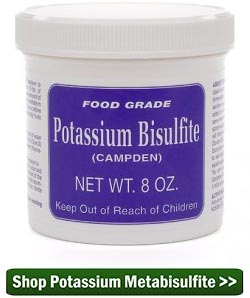 I have been thinking about a way to protect wine from unnecessary oxidation during 2nd and 3rd rackings. Mainly, I want to get the oxygen out of the empty carboy before racking into it, but how? CO2 cartridges? Dry ice? Finally hit upon a simple idea. Since I have to top up with water anyway, why not do the “topping” first, with carbonated water. The escaping CO2, being heavier, will drive everything else out of the carboy. What do you think?
I have been thinking about a way to protect wine from unnecessary oxidation during 2nd and 3rd rackings. Mainly, I want to get the oxygen out of the empty carboy before racking into it, but how? CO2 cartridges? Dry ice? Finally hit upon a simple idea. Since I have to top up with water anyway, why not do the “topping” first, with carbonated water. The escaping CO2, being heavier, will drive everything else out of the carboy. What do you think?
Walt — AR
—–
Hello Walt,
If I am understanding you correctly, you are saying to put any carbonated water needed for topping-up the wine into the empty carboy — first — before racking the wine into it. And, letting the CO2 gas from the water drive the air out of the fermenter. You would be estimating the amount of carbonated water needed for topping up.
I commend you on your idea!
In theory, what you are saying it correct. The CO2 would slowly drive air out of the vessel. The main issue I see is getting enough of the CO2 gas to release to have any real results.
Assuming you only need to top-up the wine with a quart or less of water in a 5 or 6 gallon batch, the amount of CO2 in a quart of carbonated water is not all that great. If you need to top-up the wine with a greater amount of water than this, then you shouldn’t be topping up with water at all, but rather a similar wine or some other method. Here’s some more information on different ways for topping up a wine.
Absolutely, the carbonated water would drive some of the air out of the fermenter, but not nearly all of it. There’s just not enough of it in a quart or less to do the job completely.
The second issue is getting all the CO2 gas to release from the water. Only a portion of the gas will release through agitation. The rest will want to stay saturated in the water. One way to get the CO2 gas to release more completely from the water would be to make sure it’s warm. The CO2 gas will release more freely from warm water than cold.
Having said this, I do not see any problems with putting carbonated water in the fermenter for topping-up the wine. It will be effective in driving out some air, just marginally so.
 I personally have never concerned myself with purging air from my fermenters when racking. The amount of contact time with the air is not enough to oxidize the wine in any way. Oxidation takes time. The one thing you do have to look out for is splashing. You do not want the splash the wine with racking. Fill the fermenter from the bottom up. That is, have the hose reach to the bottom of the fermenter being filled so that the hose is in the wine during the racking and not splashing.
I personally have never concerned myself with purging air from my fermenters when racking. The amount of contact time with the air is not enough to oxidize the wine in any way. Oxidation takes time. The one thing you do have to look out for is splashing. You do not want the splash the wine with racking. Fill the fermenter from the bottom up. That is, have the hose reach to the bottom of the fermenter being filled so that the hose is in the wine during the racking and not splashing.
Secondly, if [the fermentation has completed, and] you add sulfites such as Campden tablets or potassium metabisulfite to the wine after racking — as you should — you will be driving any air out of the wine and replacing it with SO2 gas in a matter of minutes.
There is nothing wrong with topping-up your wine with carbonated water. I just don’t think it will be affective in purging the air out of the fermenter.
Happy Wine Making,
Ed Kraus
—————————————————————————————————————–
Ed Kraus is a 3rd generation home brewer/winemaker and has been an owner of E. C. Kraus since 1999. He has been helping individuals make better wine and beer for over 25 years.

Make a simple co2 generator by placing vinegar in a large bottle and adding baking soda to it. Put a one-hole stopper in it with a tube running into your carboy either before or after racking. The co2 generated will displace the air in the carboy.
Went to bottle my rhubarb wine wich is a beautiful pink , added campden tablets, and it took the color out. Is therh something I can add and not loose the color ?
Larry, thanks for the great idea. I would also add that the vinegar needs to be denatured, which is usually the case.
Ron, a lot of times this is just a temporary reaction to the SO2. It will usually go away with a little time. If it does not go away after a couple of days, this would be an indication that the acidity of your wine may be to low. I would suggest testing the pH of the wine to see if it is in an acceptable range. If not, adding more Acid Blend may be necessary.
In your comments above you indicated that Campden tablets or Potassium Metabisulfite should be added to the wine after racking. Did you mean that? If it is an early racking & fermentation needs to continue, wouldn’t these additives stop the fermentation? I’m confused.
Hutch, thanks for point this out. I was referring to rackings after the fermentation was complete. I can see how this was surprising for you to read. You should never add sulfites of any kind to the wine during fermentation. I will correct this…
My grandfather used to put a layer of olive oil on top of a carboy of wine. No oxygen ever got past that layer, I recall, but I also remember a few droplets of oil always showed with a glass you were drinking.
Francisco, this is something that does work to cut the oxygen off from the wine. I have never done it myself, but have heard of several home winemakers using this trick over the years. The oil — not mixing — will form a perfect layer on top of the wine, cutting it off from the air. There are two issues here. The first one you have already mentioned: that is getting oil stirred up when bottling. The second one is that olive oil does eventually go rancid with air exposure and sun light.
Ed,
I use a vacuum transfer system ( about 20 " of vacuum)when I rack, and to increase the removal of CO2, I splash rack against the side of the glass carboy. Takes about 4 minutes. What am I missing>
Ric, there is nothing wrong with splashing the wine to help de-gas it. I would also urge you to add sulfite after doing so to help drive out any air that may have become saturated within the wine during this process. Walt is talking about something a little different. He wants to use CO2 gas to displace any air that may be in with the wine while it is being stored in bulk. This is to decrease the amount of oxidation the wine will experience.